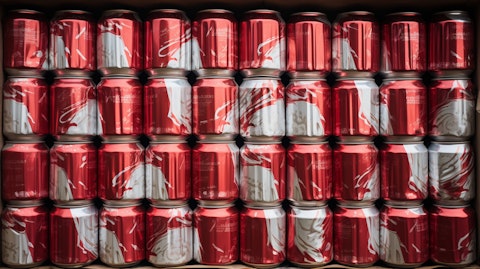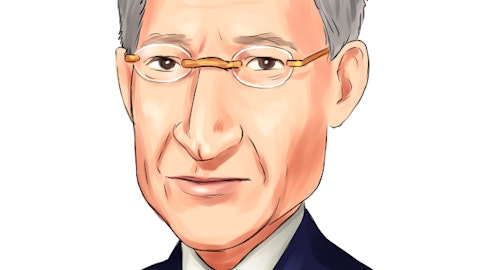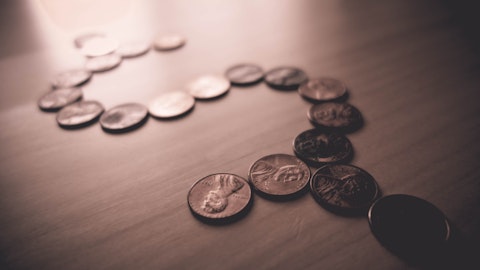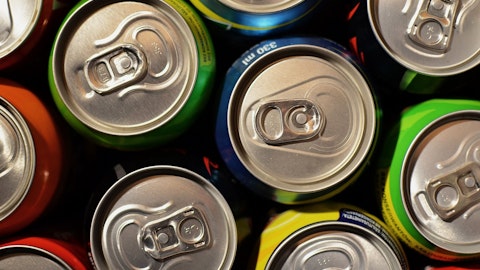Ardagh Metal Packaging S.A. (NYSE:AMBP) Q3 2023 Earnings Call Transcript October 26, 2023
Ardagh Metal Packaging S.A. reports earnings inline with expectations. Reported EPS is $0.06 EPS, expectations were $0.06.
Operator: Good day, and welcome to the Ardagh Metal Packaging Third Quarter 2023 Investor Call. Today’s conference is being recorded. At this time, I’d like to hand the call over to Mr. Stephen Lyons, Investor Relations. Please go ahead.
Stephen Lyons: Thank you, operator, and welcome, everybody. Thank you for joining today for Ardagh Metal Packaging’s Third Quarter 2023 Earnings Call, which follows the earlier publication of AMP’s earnings release for the third quarter. We have also added an earnings presentation on to our investor website for your reference. I’m joined today by Oliver Graham, AMP’s Chief Executive Officer; and David Bourne, AMP’s Chief Financial Officer. Before moving to your questions, we will first provide some introductory remarks around AMP’s performance and outlook. AMP’s earnings release and related materials for the third quarter can be found on AMP’s website at www.ardaghmetalpackaging.com. Remarks today will include certain forward-looking statements and include use of non-IFRS financial measures.
Actual results could vary materially from such statements. Please review the details of AMP’s forward-looking statements disclaimer and reconciliation of non-IFRS financial measures to IFRS financial measures in AMP’s earnings release. I will now turn the call over to Oliver Graham.
Oliver Graham: Thank you, Stephen. We delivered a robust performance in the quarter to achieve our guidance despite weaker-than-expected demand conditions in Europe. Americas performance was slightly ahead of our expectations, with North America benefiting from strong shipment growth, while Brazil was broadly in line. The deterioration in European demand during the quarter negatively impacted performance against our expectations, which we anticipate will persist into Q4. Our operating cash flow generation has significantly improved versus the prior year that underpins our conviction in a strong full year liquidity outturn. We now anticipate that full year adjusted free cash flow post our growth CapEx, which is near its completion, will be approximately $100 million, which is double our prior expectation.
Adjusted EBITDA for the company increased by 22% versus the prior year quarter. This reflected the contribution from increased shipments and a stronger recovery of input costs in Europe, predominantly due to the pass-through of energy costs. The prior year quarter also experienced a significant impact relating to metal valuation timing mismatches, which through our hedging actions and reduced inventory positions, we have substantially derisked. Global demand remains restrained by sustained retail price inflation and household financial pressures. Against this backdrop, we recorded global shipments growth of 8%, which included 18% growth in the Americas, offsetting a 2% decline in Europe. Despite our strong shipment growth, current performance continues to be impacted by fixed cost under absorption.
We are committed to a disciplined balancing of our network capacity ahead of a full recovery in industry demand through a mix of curtailment and longer-term action as appropriate. As previously outlined, we target utilization in the low to mid-90s. In our last update, we highlighted our intention to close our remaining steel lines in Germany by the end of the year, which will help to optimize our network and drive future earnings improvement. Further to this, we are today announcing that we are commencing a review of the possible closure in Q1 2024 of our White House production facility in Ohio, North America. While the possible closure of a plant is a difficult step to consider for our team members and our communities, we must take steps to balance capacity and demand.
As part of our collective bargaining agreement, we have notified employees and union representatives, and a final decision is expected before the end of this year. Out of sensitivity to those possibly affected into the process, we will not be making any further comments on the review at this point. We continue to progress our sustainability agenda and highlights in the quarter included the expansion of our Ardagh Education STEM program to Brazil, where our 10-year investment will benefit approximately 200,000 students across the communities in which we operate. Through the Can Manufacturers Institute in the U.S., we made further investment into recycling infrastructure and also launched a sustainable zero emissions distribution partnership in the Netherlands.
We expect to shortly publish our 2023 sustainability report, further highlighting our progress, and we are pleased that this continues to be recognized externally, which includes the award of a platinum rating by EcoVadis to Ardagh Group, including AMP in the quarter. Turning our attention to AMP’s third quarter results. We recorded revenue of $1.3 billion, which represented an increase of 10% as the contribution from higher volume mix and stronger nonmetal input cost recovery more than offset the pass-through of lower metal prices. Adjusted EBITDA of $171 million was up 22% on the prior year. The impact from higher shipments and stronger input cost recovery was partly offset by higher operating costs due to fixed costs under absorption. Total beverage can shipments in the quarter were 8% higher than the prior year, with 18% growth in Americas offsetting a 2% decline in Europe.
Our working capital net inflow of $53 million compares favorably with a net outflow of $50 million in the prior year quarter and drove a strong overall cash performance. Now looking at AMP’s results by segment. Revenue in the Americas in the third quarter increased by 8% to $732 million, which reflected shipments growth, partly offset by lower input costs, largely as a result of lower metal prices. In North America, shipments grew by 20% for the quarter. This strong shipment growth is driven by the contribution from customer contract commitments backing our investment program, setting a platform for future growth as well as the benefit from a diverse mix in our portfolio, which includes some favorable high-growth segments such as functional energy drinks.
Looking at the market overall, demand remains constrained by sustained higher retail pricing and lower promotional activity, which although increasing slightly remains limited in terms of its depth relative to historic levels. Inflationary pressures are moderating, which gives some cause for optimism regarding a recovery in industry demand. What remains apparent through these demand pressures is that the Can is still winning in terms of substrate mix and also through the launch of innovative new products favoring beverage cans as the package of choice. We’re encouraged by the increased annual growth in shipments across the most 2 recent consecutive quarters as well as our early momentum into the fourth quarter, and this supports our forecast for shipments in our North America business to grow by over 10% this year.
In Brazil, third quarter shipments increased by 8%, outperforming the low single-digit increase in the market, which benefited from improving economic conditions and favorable weather towards the end of the quarter. Market demand overall remains challenged by consumer inflationary pressures and a higher mix of returnable glass bottles than anticipated in the market. Our relative outperformance reflected a recovery following customer destocking during Q2. We would note that negotiations between a major customer and its creditors are concluding, and an agreement has been reached under the court supervisory organization process. Our outlook is unchanged, and the agreement is expected to be ratified imminently. Following their destocking during the second quarter, more normal order patterns have now resumed.

This recovery as well as other customer mix effects underpin our higher relative shipments growth versus the market in the period. Profitability was modestly impacted by some timing-related issues that should reverse in the fourth quarter. Our forecast remains for broadly flat shipments growth for our Brazil business in 2023, and we continue to balance our capacity through curtailment of our network. We reiterate our confidence in the medium-term growth characteristics of the Brazil market, which has historically been a highly attractive beverage can market. Adjusted EBITDA in the Americas increased by 2% to $104 million in the third quarter as the contribution from higher volumes was offset by higher costs, including fixed cost under absorption that remained elevated as destocking was prioritized in North America.
This destocking is now complete and has helped underpin the strong cash flow performance and improved liquidity in the period. In 2023, we continue to expect shipments growth in the Americas of mid- to high single-digit percentage, underpinned by continued strong shipments growth in North America. Fixed cost underabsorption, net of our mitigating curtailment actions, remains a headwind to our performance. We will continue to take the necessary actions to balance our capacity in line with demand conditions. And as mentioned, we have today announced the review of a possible closure of our White House facility in Ohio, which represents approximately 10% of our North American capacity. We anticipate a further modest sequential improvement in EBITDA into the fourth quarter supported by our momentum on shipments growth in North America and the seasonally stronger summer selling period in Brazil.
Our performance versus the prior year will remain impacted by fixed cost under absorption and a nonrepeating customer take-or-pay payment from Q4 2022. In Europe, third quarter revenue increased by 14% to $562 million compared with the same period in 2022, mainly due to more favorable input cost recovery. Shipments for the quarter declined by 2% on the prior year as momentum through Q2 and into the early part of the summer fell away, impacted by consumer pressures, adverse weather and customer destocking. The softening in demand was broad-based across categories and end markets, but it was more pronounced in Germany, Central Europe and in the beer market with the energy drink segment, one notable area of strength. Third quarter adjusted EBITDA in Europe increased by 76% to $67 million despite the lower shipments, which predominantly reflected improved input cost recovery principally from the pass-through of energy costs.
For 2023, we now expect broadly flat shipments growth, which assumes a mid-single-digit percentage decline in the fourth quarter. Reflecting this deterioration in demand, both from market weakness and customer destocking, we no longer anticipate a significant increase in adjusted EBITDA in the fourth quarter versus the prior year. As mentioned in our last quarter call, it remains our intention to optimize our footprint in Europe through the closure of our remaining steel lines in Weissenthurm, Germany by the end of the year and to fully migrate to 2 new efficient aluminum lines. And we are making good progress in our discussions with the workforce. I’ll now briefly hand over to David to talk you through our financial position before finishing with some concluding remarks.
David Bourne: Thanks, Ollie. And hello, everyone. Moving now to our financial position. We ended the quarter with a liquidity position in excess of $0.5 billion, and we are no longer drawing on our ABL facility. Our adjusted operating cash flow in the period, again, performed strongly due to the success of our working capital initiatives. The further rightsizing of our North American inventory, which is now complete, impacted on our EBITDA performance in the quarter, but this underpinned our strong cash flow performance, which was further enhanced by good progress on days sales outstanding for trade receivables. The success of working capital initiatives allows us to further increase our guidance for a full year working capital benefit to approaching $200 million.
This compares with our initial guide of $100 million. Overall, our adjusted free cash flow for the first 9 months of the year is $310 million better than the prior period equivalent. In the quarter, AMP incurred additional growth CapEx of $54 million and maintenance CapEx of $28 million. As previously indicated, our revised growth investment plans are well advanced, and cash outflows comprised the finishing of projects already underway as well as some CapEx to add flexibility to our network. Our expectation for the current year is unchanged, which includes growth investment of just under $0.4 billion with the cash flow element under $0.3 billion. We anticipate that growth CapEx will fall further to circa $0.1 billion in 2024 and beyond. Our leverage metric ended the quarter 5.7x last 12 months adjusted EBITDA, supported by lower net debt and an improving LTM adjusted EBITDA.
This represents a decline of 0.5x of leverage relative to the Q2 position, which we indicated represented a peak position. Supported by our stronger cash flow generation performance and expectation of a stronger year-end liquidity position of circa $700 million, we expect a further reduction in net leverage into year-end. In addition to our strong liquidity position, we have no near-term bond maturities and none of our fixed rate bonds maturing ahead of 2027 with known maintenance covenants on our bonds. We have today announced our quarterly ordinary dividend of $0.10 per share to be paid later in December, in line with our guidance and supported by the cash generation of our business. Our capital allocation strategy will continue to prioritize dividend sustainability and deleveraging.
With that, I’ll hand back to Ollie.
Oliver Graham : Thanks, David. Before moving to take your questions, I’ll just recap on the key messages and our performance. So we achieved our Q3 guidance by our global shipments growth of 8%, led by strong shipments growth of 18% in the Americas, offsetting a decline of 2% in Europe, where we do see demand weak into Q4. Our operating cash flow generation continues to perform strongly. And despite our lower earnings forecast for 2022, we’re improving our free cash flow forecast and anticipate a stronger year-end liquidity position than previously forecast. And we remain focused on prudently managing our capacity, addressing our fixed cost under absorption and supporting future earnings improvement. We lower our guidance for 2023 to include global shipments growth of approximately a mid-single-digit percentage, reflecting the weaker-than-expected demand in Europe and expect adjusted EBITDA in the order of $610 million, which also reflects the weaker outlook in Europe.
In terms of guidance for the fourth quarter, adjusted EBITDA is anticipated to be in the order of $158 million, which is broadly in line with prior year adjusted EBITDA of $159 million. Having made these opening remarks, we’ll now proceed to take any questions.
Operator: [Operator Instructions] We’ll go ahead and take our first question from Mike Roxland with Truist Securities.
See also America’s Top 20 States for Business in 2023 and 20 Best US Cities for Nature Lovers and Outdoor Enthusiasts.
Q&A Session
Follow Ardagh Metal Packaging S.a. (NYSE:AMBP)
Follow Ardagh Metal Packaging S.a. (NYSE:AMBP)
Mike Roxland : Looking at North America, volumes up 20% in 3Q. Just wanted to get a sense of whether that was in line with your internal plan or better. Obviously, some of that’s related to the new capacity you bought online. But just trying to get a sense. It’s really very strong there, but trying to get a sense whether that was better than you expected. And if so, what factors were driving that.
Oliver Graham: Yes. Thanks, Mike. I think it was a point or 2 above our internal expectation. We did have good growth prospects for this year in our plans, which we signaled at the beginning of the year, and we repeated in Q2. So I think it was better but not dramatically better than how we saw the year and how we saw the quarter. And as I said in my remarks, I think we’re sitting on some nice growth spaces in the market with the functional energy in particular, but other innovation that’s coming through to the market. I think the Can continues to be the home of innovation, particularly in North America, and we’re seeing some great products come to market and really pop. And then we also had a strong performance in other categories.
We had some good mix of locations and bottlers on the carbonated soft drink side. So yes, we definitely sat on the right side of the market in the quarter. I think we see the market broadly as others are seeing it. So it’s probably sort of overall flat to slightly positive with a balance that we see imports coming down in the import data. So domestic production will be a bit above, a few points above. So the market is still a bit depressed by the strong retail pricing that our customers have put in place in the last 12 months. But again, I think we see that washing out in the next few months. So we feel good about 2024 in terms of the market returning to growth, and we feel good about our growth prospects for ’24 in North America as well.
Mike Roxland : Got it. Appreciate all the color there, Ollie. Just one follow-up. If demand is so strong, as you say it is, and you’re expecting demand to further improve in ’24, what do you feel — portfolio rationalization you mentioned isn’t necessarily — I know you may not be able to comment further with respect to your ability, so I totally understand that. But it just seems if things are truly getting better and you’re exploring about right now and you’re only going some improvement next year, that it would make sense to have all your assets in place to address that demand.
Oliver Graham: No, I understand the question. As I said, I think the market will improve next year. I didn’t say we’ll do better than our performance this year. I think that would be a strong statement at this point, and we’re not guiding on ‘24 yet, but we do see good volume growth in North America in 2024. So look, I think it’s simply a question of the growth that we originally expected, both on the side of the hard seltzers, but also generally in the market and the last 2 years has been a big step down for all players and expectations due to the inflationary price environment. So when we netted all that out, looked out a few years, we were still carrying and we still are carrying too much fixed cost relative to that even with the strong growth that we’ve had. So therefore, we felt it was appropriate to start the consultation process, which, as you say, I can’t say any more about that at this point.
Operator: And our next question comes from Anthony Pettinari with Citi.
Anthony Pettinari : In Brazil, you talked about customer destocking. And I was wondering if you could just help us understand where customers are in that process. And then with regards to glass containers, I think you talked about the Can winning globally. Just wondering how that dynamic is playing out in Brazil this year. And are there reasons to think as we look to ’24 that cans may regain some share or hold share or lose share? Like how would you describe the dynamic there currently?


